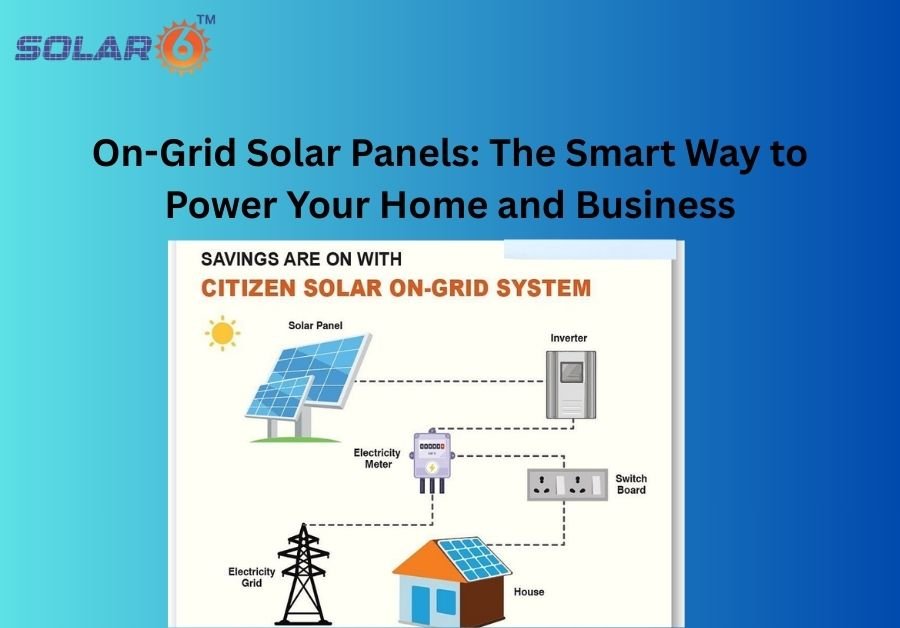As energy costs rise and climate concerns grow, more homeowners and businesses are turning to solar power systems. Among the different types of solar setups available, on-grid solar panels (also called grid-tied solar systems) are the most popular choice. They offer a perfect balance of affordability, efficiency, and long-term savings while allowing users to stay connected to the local electricity grid.
In this article, Solar6 explores everything you need to know about on-grid solar panels—how they work, their benefits, costs, and why they’re the smartest investment in clean energy.
What Are On-Grid Solar Panels?
On-grid solar panels are connected directly to the local utility grid. Instead of relying solely on batteries, they generate electricity during the day and supply excess power back to the grid. At night or during cloudy days, when panels produce less energy, electricity can be drawn from the grid.
This seamless connection ensures a reliable and uninterrupted power supply.
How Do On-Grid Solar Systems Work?
The functioning of an on-grid solar system involves four key steps:
Power Generation – Solar panels capture sunlight and convert it into DC electricity.
Conversion – A solar inverter converts DC into AC power, making it usable for household appliances.
Consumption – Electricity is used instantly by appliances in your home or business.
Excess Power Export – Surplus electricity is fed back into the grid through a net metering system, earning credits on your electricity bill.
Benefits of On-Grid Solar Panels
1. Lower Electricity Bills
With net metering, your unused solar energy offsets the electricity you draw from the grid, significantly reducing monthly utility bills.
2. Cost-Effective Installation
Unlike off-grid systems, on-grid solar panels do not require expensive solar batteries, making them more affordable.
3. Reliable Energy Supply
Since you remain connected to the grid, you have a continuous power source—even when your solar panels aren’t producing enough energy.
4. High Return on Investment (ROI)
Most on-grid solar systems pay for themselves within 4–6 years, after which you enjoy free electricity for decades.
5. Eco-Friendly
By reducing reliance on fossil fuels, you lower your carbon footprint and contribute to a cleaner environment.
On-Grid vs Off-Grid vs Hybrid Solar System
| Feature | On-Grid Solar | Off-Grid Solar | Hybrid Solar |
| Grid Connection | Connected | Independent | Connected + Battery |
| Battery Requirement | Not required | Required | Optional |
| Cost | Affordable | Higher | Medium-High |
| Best For | Urban homes, businesses | Remote areas | Backup + Savings |
| Net Metering | Available | Not available | Available |
Components of an On-Grid Solar System
Solar Panels – Monocrystalline or polycrystalline panels convert sunlight into electricity.
Solar Inverter – Converts DC power into usable AC power.
Net Meter – Tracks electricity imported from and exported to the grid.
Mounting Structure – Supports and positions the panels for maximum sunlight exposure.
Wiring & Safety Equipment – Ensures smooth power flow and system safety.
Installation Process
Site Assessment – Experts analyze roof space, shading, and energy needs.
System Design – Engineers create a customized solar plan.
Government Approvals – Applications for subsidies and grid connection are processed.
Installation – Panels, inverters, and net meters are installed.
Grid Synchronization – The system is connected to the grid and activated.
Cost of On-Grid Solar Panels
The cost of an on-grid solar system depends on system size and panel type. Approximate prices in India (after subsidies):
- 1 kW On-Grid System – ₹60,000 – ₹80,000
- 3 kW On-Grid System – ₹1,60,000 – ₹2,00,000
- 5 kW On-Grid System – ₹2,50,000 – ₹3,50,000
With subsidies covering up to 40% for residential rooftop solar panels, installation becomes even more affordable.
Government Subsidies and Net Metering Benefits
Residential Rooftop Subsidy – Up to ₹78,000 under the PM-Surya Ghar Muft Bijli Yojana.
Net Metering – Credit for excess energy exported to the grid, reducing future bills.
Tax Benefits – Businesses can claim depreciation benefits on solar investments.
Maintenance of On-Grid Solar Panels
Maintenance is minimal compared to other systems:
- Clean panels every 3–6 months to remove dust.
- Check inverter performance regularly.
- Monitor net meter readings to ensure accurate billing.
Who Should Choose On-Grid Solar Panels?
- Urban households with a reliable grid supply.
- Businesses and industries are looking to cut electricity costs.
- Schools, hospitals, and institutions are aiming for sustainable operations.
- Commercial buildings with large rooftop spaces.
- Environmental Benefits of On-Grid Solar Panels
- Reduce dependence on fossil fuels.
- Lower greenhouse gas emissions.
- Conserve water (unlike thermal power plants).
- Promote clean, renewable energy adoption.
- Future of On-Grid Solar Systems
With increasing government support, falling panel prices, and rising electricity demand, on-grid solar panels will dominate the renewable energy sector in the coming years. Innovations like AI-powered monitoring systems, bifacial solar panels, and smart grids will further enhance their efficiency and affordability.
Conclusion
On-grid solar panels are the most practical, cost-effective, and eco-friendly solution for homes and businesses seeking to reduce energy bills and embrace sustainable living. By staying connected to the grid while generating your electricity, you enjoy the best of both worlds—energy savings and uninterrupted supply.
Switching to on-grid solar panels isn’t just about saving money; it’s about investing in a cleaner, greener, and more sustainable future.

